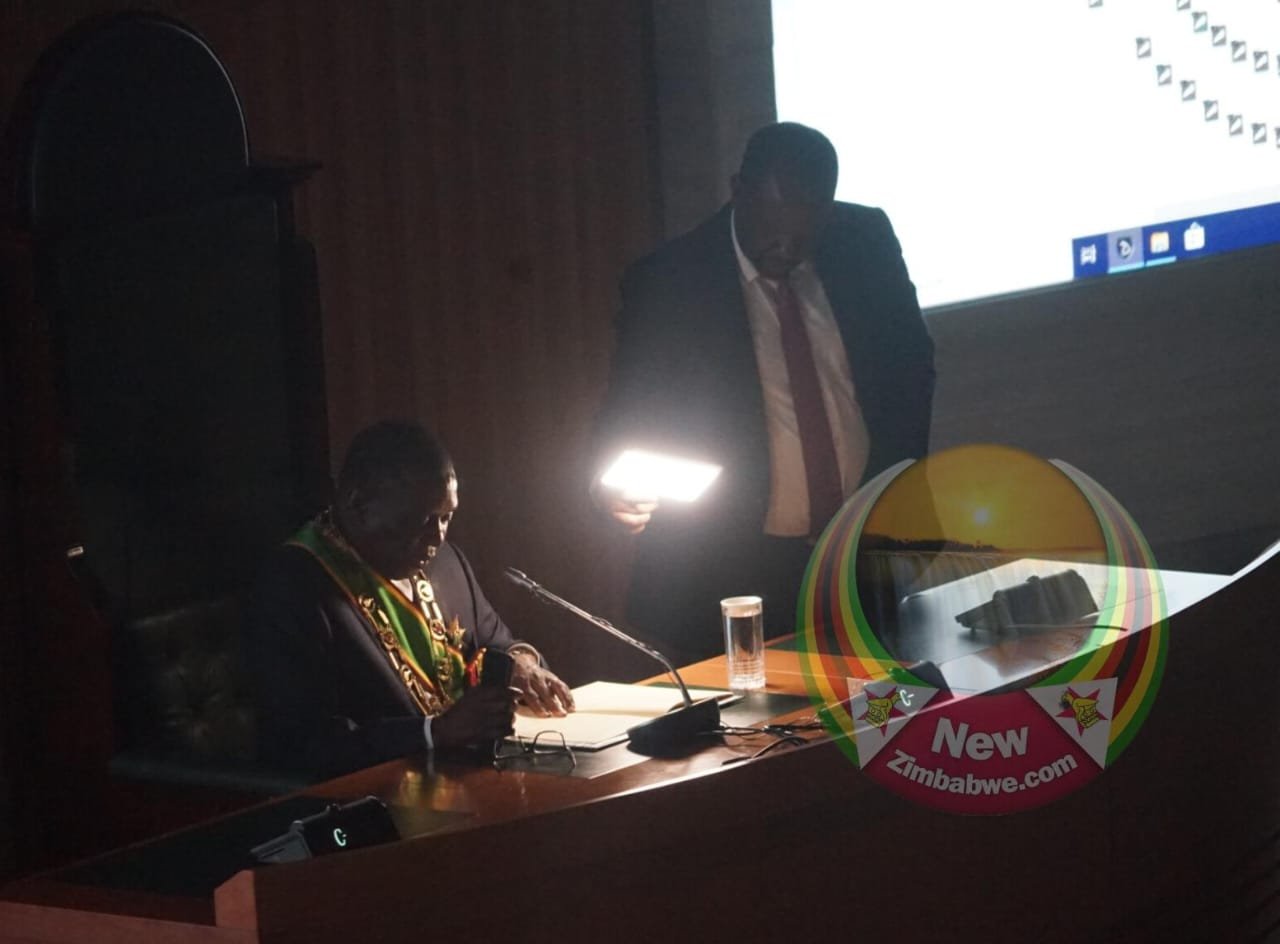Power Outage Plunges Zimbabwe Parliament Into Darkness During Mnangagwa’s SONA, Prompting Swift Executive Dismissal
HARARE, Zimbabwe – A dramatic power failure plunged Zimbabwe’s new Parliament Building into darkness during President Emmerson Mnangagwa’s State of the Nation Address on Tuesday, creating an embarrassing national spectacle that culminated in the immediate dismissal of the country’s power distribution chief and raised serious questions about infrastructure stability and political accountability.
The unprecedented incident, which forced Mnangagwa to complete his address under torchlight for approximately ten minutes, represents the second major power failure at Parliament during a high-profile government event in less than a year. The recurrence has triggered widespread public ridicule and prompted speculation about possible sabotage within the nation’s power infrastructure.
A National Address Delivered in Darkness
President Mnangagwa was midway through delivering his much-anticipated State of the Nation Address to a joint sitting of Parliament when the chamber suddenly lost all power, creating the surreal scenario of a national leader continuing his policy address in near-total darkness. The Zimbabwe Mnangagwa SONA torchlight episode saw presidential aides scrambling to provide illumination using mobile phones and flashlights, allowing the president to complete his speech despite the technical failure.
“Preliminary investigations indicate that a circuit breaker supplying the load had tripped. The restoration took longer than expected, resulting in part of the SONA being delivered without power,” Clerk of Parliament Kennedy Chokuda stated in a formal explanation attempting to address the embarrassing incident.
According to parliamentary officials, the building was operating on generator power as the primary source with Zimbabwe Electricity Supply Authority (ZESA) power serving as backup when the failure occurred. The technical explanation, however, did little to quell the political storm that followed the very public infrastructure failure during one of the government’s most important annual events.
Speaker of Parliament Jacob Mudenda later apologized to President Mnangagwa, who had departed the building immediately after concluding his address. However, Mudenda also raised the possibility of deliberate sabotage, issuing a stark warning that reverberated through political circles. “The culprit will regret the day of their existence,” Mudenda declared, suggesting the incident may have been more than mere technical malfunction. For continuous updates on this developing political story, our Zimbabwe news desk is providing comprehensive coverage.
This marks the second power outage to occur at the Parliament Building during a major governmental proceeding with President Mnangagwa present. The first incident took place during Finance Minister Mthuli Ncube’s 2025 National Budget Presentation in November last year, which ZESA had previously attributed to “natural causes.” The recurrence, despite specific arrangements to ensure backup power functionality, has intensified scrutiny on the country’s energy sector management and maintenance protocols.
Political Fallout and the Dismissal of ZETDC Chief
The political repercussions were swift and severe. Within hours of the incident, the Managing Director of the Zimbabwe Electricity Transmission and Distribution Company (ZETDC), Abel Gurupira, was dismissed from his position with immediate effect. The dramatic move signaled the administration’s urgency to demonstrate accountability and contain the political damage from the very public infrastructure failure.
Sources within the Ministry of Energy confirmed that Energy Minister July Moyo personally ordered Gurupira’s removal, instructing Group CEO Cletus Nyachowe to act without delay.
The decision to fire the ZETDC boss fired represents one of the most rapid executive dismissals in recent Zimbabwean political history, underscoring the sensitivity of the incident and the administration’s determination to be seen as taking decisive action. An internal investigation has been launched to establish the precise cause of the outage, which has become symbolic of broader challenges within Zimbabwe’s power infrastructure under the current administration.
The incident has sparked nationwide discussion and criticism, with many Zimbabweans interpreting the blackout as a stark metaphor for perceived governance failures and the country’s ongoing electricity challenges. Social media platforms were flooded with commentary and memes contrasting the government’s ambitious policy promises with the reality of being unable to maintain basic electricity during its most important annual address.
“The loss of power supply to key systems occurred when the Parliament Building was running on a generator as the main source of supply, with ZESA power as a standby. When supplies were lost, the generator was still running but not supplying power,” Chokuda’s statement elaborated, attempting to provide technical clarity on the sequence of failures.
Parliament has announced it is working with the Ministry of Local Government, ZESA, and other relevant government agencies to conduct a comprehensive investigation into the incident. Officials have promised that findings will be made public once investigations are complete, with appropriate measures implemented to prevent recurrence. However, given the previous outage and the current failure despite existing contingency plans, public skepticism remains high regarding the effectiveness of these proposed solutions.
The timing of the blackout during a nationally televised event highlighting the administration’s achievements has created a powerful visual contradiction that opposition figures and critics have been quick to emphasize. The image of President Mnangagwa persevering through darkness has become a potent symbol interpreted differently across the political spectrum – as either demonstration of resilience in adversity or as emblematic of systemic governance failures.
The dismissal of the ZETDC boss fired represents more than just personnel change; it signals the political prioritization of this incident within the administration. The power utility has long struggled with maintaining consistent electricity supply nationwide, with regular load-shedding affecting households and businesses across Zimbabwe. This very public failure at the heart of government has intensified existing frustrations with the sector’s performance.
As investigations continue, questions remain about whether the circuit breaker failure was indeed an isolated technical incident or symptomatic of deeper systemic issues within Zimbabwe’s power infrastructure. The incident has also raised concerns about the vulnerability of critical government installations to technical failures, particularly during important national events with significant security implications.
The Zimbabwe Mnangagwa SONA torchlight address will undoubtedly become a defining moment of the political calendar, representing both the administration’s determination to continue despite challenges and the persistent infrastructure problems that continue to plague national development efforts. The government’s response in the coming weeks, including the results of the promised investigation and any additional accountability measures, will be closely watched by both domestic observers and the international community. Further details on the government’s response to this incident can be found through reputable sources like AllAfrica.


